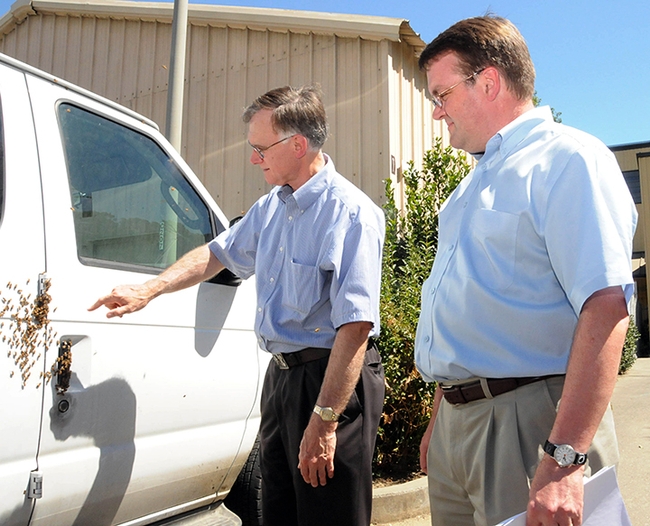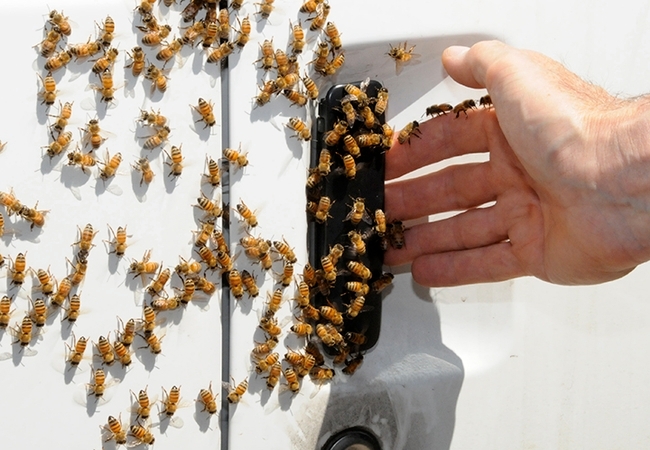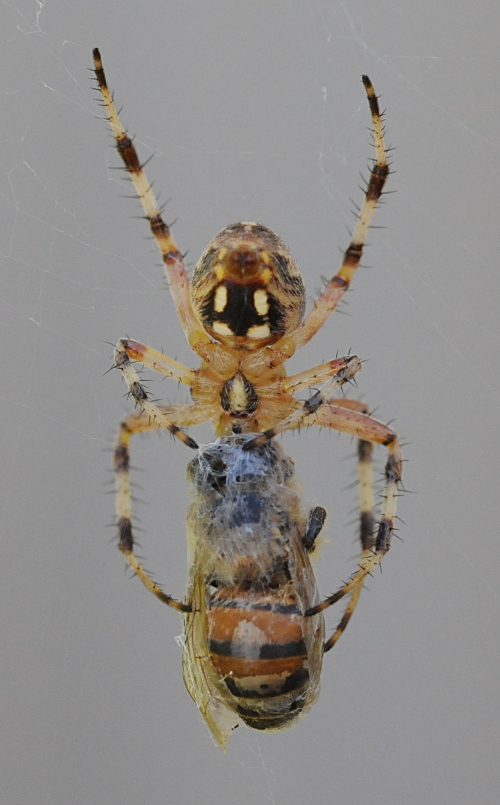- Author: Kathy Keatley Garvey

My inaugural Bug Squad blog on Aug. 6, 2008 dealt with a swarm of bees that "hitched" a ride on Aug. 1 from El Cerrito to UC Davis on a commuter van.
"At 7 a.m., a group of UC Davis employees approached their commuter van in an El Cerrito parking lot. But, after glancing at the passenger side, they weren't at all sure they wanted to board. A huge swarm of bees bearded the entire passenger side of the vehicle and part of the windshield. Thousands of bees. Did I say thousands of bees? Thousands of bees."
"What to do? Knowing about colony collapse disorder and the declining bee population, they didn't want to hurt them. So they climbed in the van via the driver's side and circled the block, hoping the bees would disperse. They didn't."
"In an un-bee-lievable sight, the white van, accompanied by the bees and their queen, buzzed to the UC campus on a 60-mile freeway ride. When the vehicle pulled into the Shields parking lot shortly before 8 a.m., so did a long line of bees hanging around the door frame."
“We lost most of them along the way,” vanpool driver Keir Reavie, head of the Biological and Agriculture Sciences Department at Shields Library, told us.
How did the survivors survive?
That was the question.
Cooperative Extension apiculturist Eric Mussen, based in the UC Davis Department of Entomology (it's now the Department of Entomology and Nematology) explained that "some bees must have slipped inside the door frame and held on to the others by linking legs. The queen bee was probably inside the crack.”
Mussen recommended that the commuters leave them alone or contact a beekeeper on campus or in El Cerrito to vacuum off the swarm. “The bees in a swarm usually won't bother you unless they are significantly disturbed,” he said.
Meanwhile, the social insects spent the day on campus, periodically leaving the van for food and water, while others—the scouts—searched for a new home. Some bees parked on the “Van Pool Parking Only” sign and the motorcycle permit parking sign. A spider took the opportunity to snack on a bee snared in its web.
So many memories.
And so many memories of the incredible Eric Mussen, who died June 3 at age 78 after being diagnosed with liver cancer on May 31. We are all grieving and heartbroken over the tremendous loss of our friend, colleague and fellow human being who loved bees and delighted in sharing information about them.
Mussen, who served as the state's Extension apiculturist for 38 years, joined our Department of Entomology in 1976, and retired in 2014. But he never really retired. He kept busy during his retirement years with his various projects, including serving as the 2017 president of the Western Apicultural Society for the 40th anniversary conference at UC Davis.
He gained state, national and international stature for his expertise on bees and his skills as a science communicator. You may have heard him on National Public Radio (Science Friday) or on BBC or read about him in the nation's top newspapers. (Read the tributes from colleagues, fellow scientists, bee breeders and beekeepers on the Department of Entomology and Nematology website.)
For nearly four decades, Eric drew praise as “the honey bee guru,” “the pulse of the bee industry" and "the go-to person" when consumers, scientists, researchers, students, and the news media sought answers about honey bees.
“Eric's passing is a huge loss," said longtime colleague Lynn Kimsey, director of the Bohart Museum of Entomology and a UC Davis distinguished professor of entomology. "He was always the go-to person for all things honey bee. He worked happily with hobbyists, commercial beekeepers and anyone just generally interested."
Eric was, indeed, the "go-to" person for all things honey bee.
"I was such a fan of Eric and he was an educator of everything honey bees and an all-around great guy," Christine Souza, assistant editor of Ag Alert, told us this morning. "For many years he was an amazing source for me for Ag Alert. No one had the knowledge or charisma that he had to talk about entomology and make the average person out there listen to scientific information. He was great at it and made me want to learn more about bees every time I had the great opportunity to talk to him. I feel very blessed to have met him and interviewed him."
We were all blessed. It was a honey of a ride and he left a whale of a legacy.
(A Celebration of Life for Eric Mussen is planned from 4 to 6 p.m., Sunday, Aug. 28 in the Putah Creek Lodge, UC Davis campus.)


- Author: Kathy Keatley Garvey
A funny thing happened on the way from El Cerrito to UC Davis on Friday, Aug. 1.
And it wasn't even Friday the 13th.
At 7 a.m., a group of UC Davis employees approached their commuter van in an El Cerrito parking lot. But, after glancing at the passenger side, they weren't at all sure they wanted to board.
A huge swarm of bees bearded the entire passenger side of the vehicle and part of the windshield. Thousands of bees. Did I say thousands of bees? Thousands of bees.
What to do? Knowing about colony collapse disorder and the declining bee population, they didn't want to hurt them. So they climbed in the van via the driver's side and circled the block, hoping the bees would disperse. They didn't.
In an un-bee-lievable sight, the white van, accompanied by the bees and their queen, buzzed to the UC campus on a 60-mile freeway ride.
When the vehicle pulled into the Shields parking lot shortly before 8 a.m., so did a long line of bees hanging around the door frame.
“We lost most of them along the way,” said vanpool driver Keir Reavie, head of the Biological and Agriculture Sciences Department at Shields Library.
How did the survivors survive?
“Some bees must have slipped inside the door frame and held on to the others by linking legs,” said UC Davis apiculturist Eric Mussen. “The queen bee was probably inside the crack.”
Lynn Kimsey, professor and chair of the Department of Entomology and director of the Bohart Museum of Entomology, noticed the bees on the van when she pedaled over to Shields Library early Friday afternoon.
She alerted Mussen. But he already knew about them.
Reavie had earlier emailed him, asking what to do.
Mussen recommended that they leave them alone or contact a beekeeper on campus or in El Cerrito to vacuum off the swarm. “The bees in a swarm usually won't bother you unless they are significantly disturbed,” he said.
Meanwhile, the social insects spent the day on campus, periodically leaving the van for food and water, while others—the scouts—searched campus buildings for a new home. Some bees parked on the “Van Pool Parking Only” sign and the motorcycle permit parking sign.
At least one bee casualty occurred in the Shields parking lot: a bee flew into a nearby spider's web. When Mussen arrived at the site, the spider was feasting on the web-wrapped bee. A taste of honey.
What happened to the bees? "I was not able to contact the person Eric suggested on Friday afternoon, so nobody came to take the bees," Reavie said. " When I returned to the van at 5 p.m., most of the bees had left, but there was still a large group on the passenger side rear view mirror. Some of these dispersed on the trip back to El Cerrito and the few remained were gone when I checked on the van Saturday afternoon."
As for the UC Davis commuter van, it's now “the bee mobile."
Let's hear it for our "unstung heroes."




